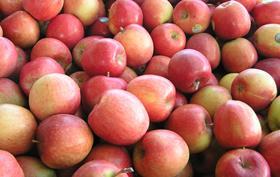
It’s no secret that this has been a difficult season for the British topfruit industry and with UK supply now winding down, the switchover to southern hemisphere apples in May is likely to leave a gap.
Cox and Braeburn were worst affected by last spring’s frosts, which struck during the blossom period for both varieties. As expected, neither recovered from the setback and OrchardWorld reported that its Cox season finished seven to eight weeks earlier than normal, with a similarly short supply period for Braeburn.
Low volumes of British Braeburn have increased demand for imports from Europe, particularly France, and OrchardWorld’s Alan Griffiths warns that supplies are drying up very quickly, sending prices “through the roof.” “If you’re stuck in tender prices, as a lot of us are these days, it’s proven to be quite difficult to honour your programme,” he says.
However, James Simpson of Adrian Scripps praised UK supermarkets for being flexible with suppliers when it came to the British crop. “Credit to the retailers, who were prepared to discuss quality and fruit-size issues and adjust specification to maximise availability,” he says. “Tesco and Sainsbury’s were particularly proactive in this respect.”
One knock-on effect of the shortages has been a 20 per cent jump in Gala consumption in the past two weeks, according to Griffiths, with lots of shoppers switching to the variety in the absence of Cox and Braeburn. “You rarely see a jump to a premium line like Pink Lady,” he explains. “Instead, people tend to switch to an everyday lower price apple like Gala, but I can’t recall this happening for many years.”
On a wider scale, apple suppliers are worried by the prospect of a few weeks’ supply gap between the end of the northern hemisphere season and the start of southern hemisphere supply, which is likely to begin in mid-May. Meanwhile, in pears, there has been a considerable drop in total production south of the equator, but Griffiths says suppliers have been leaning more on northern hemisphere sources like Belgium and the Netherlands, and he is confident volumes will be large enough to match retail demand.
When it comes to market performance, value sales were up 5.7 per cent year on year despite a 3.9 per cent drop in volumes in the 52 weeks to 25 February. Simpson explains that premium apples still seem to be enjoying sales growth – notably Pink Lady, Jazz and Kanzi – but most other varieties “remain static at best”.
One variety set for a big rise is Cameo, with output predicted to more than double over the next five years as growers invest in wide-scale plantings.
In 2017-18 an additional 80,000 trees are being planted in Britain, with 60,000 to follow in each of the following two seasons. That is expected to increase output to around 7,000t by 2022-23. “Cameo, along with apples such as Red Prince, has potential for longer-term storage,” explains Scripps. “This should allow a British apple to be marketed 12 months of the year, assuming consumer demand is there.”
There are calls for similar orchard expansion in pears, with AGPO’s general manager Sarah Calcutt urging growers in the producer organisation to plant more of the fruit, namely in the Conference and Migo varieties. Carol Ford of AC Goatham & Son also welcomed a year-on-year increase in British pear volumes from around 40 million to 50m fruits*, with new orchards now coming on stream.
Calcutt says the age of UK pear orchards is a challenge, with some up to 74 years old. This can present difficulties in terms of productivity and fruit shape, she explains: “You can get a great crop off an old tree but for the modern, smooth-skinned varieties you probably need to think differently.”
*Corrected from an incorrect previous version



